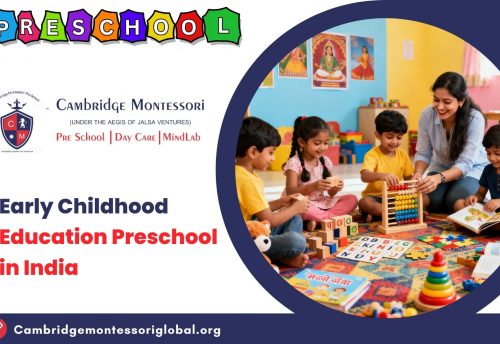
Top 10 Indoor Activities for Preschooler at Home
There’s something beautiful about seeing your child learn at home. A pile of cups can become a castle; a spoon and a bowl transform into a science laboratory. A book of stories is a gateway to the world of imagination.
Indoor time does not restrict; it creates opportunities to turn ordinary, one-dimensional moments into meaningful learning that builds confidence, concentration, and happiness. In this blog, we are going to discuss 10 basic and Montessori-inspired indoor activities that parents and teachers can try at home. Each activity encourages independence, motor development, innovative thinking, and emotional growth.
Let’s begin. By the end, you’ll have a full plan to create meaningful learning moments at home today.
1. Pouring and Transferring
Serve dishes, forks, and dry grains (e.g., rice or pulses). Ask your child to pour from one container to another.
This develops:
- Hand-eye coordination
- Patience
- Focus
Confidence through real-life tasks in Montessori. When children do something independently, they feel competent.
2. Folding and Sorting Clothes
Prepare napkins or towels. Demonstrate folding once, then let them try. Next, arrange clothes by size or color.
Skills gained:
- Order and structure
- Independence
- Practical life skills
Children also practice this in a Montessori preschool classroom.
3. Paper Collage and Finger Painting
Arrange colored paper, glue, and safe paints on a tray. Let children freely discover and create.
Benefits:
- Fine-motor strength
- Creative expression
- Emotional release
UNICEF says creative play boosts cognitive and social abilities in young children.
4. Reading Corner Time
Set up a comfortable reading spot with cushions and picture books. Let your child choose a book and browse through it.
Why it matters:
- Builds love for reading
- Improves language skills
- Teaching silent concentration and tranquillity.
This is similar to a prepared environment in Montessori child care schools in India.
5. Object Sorting and Matching
Gather household items like blocks, spoons, and bottle caps. Arrange them by size, color, shape, and more.
Supports:
- Early math readiness
- Logic and reasoning
- Visual discrimination
Basic trays and baskets are fundamental in a Montessori-inspired home.
6. Tape Balance Walk
Lay masking tape in a straight line on the floor to create a “balance beam.” Have your child walk along the line.
Builds:
- Balance and coordination
- Body awareness
- Motor regulation
Fun twist: Ask them to walk backwards, on tiptoe, or while carrying a soft toy.
7. Musical Freeze Dance
Play music and let your child dance. Pause the music—they freeze! Play again—they move!
This develops:
- Rhythm
- Listening skills
- Self-control and discipline
Movement within the home is essential—about 80 percent of brain development occurs before age 5 (CDC).
8. Sensory Trays and Mystery Bags
Prepare a tray with sand, rice, or flour and hide small objects. Ask them to feel and guess, or make a cloth mystery bag with hidden items.
Skills developed:
- Sensory awareness
- Vocabulary
- Concentration
Sensory play helps organize the brain and is key in Montessori preschool education.
9. Story Retelling and Role-Play
Read a story to your child and ask them to act it out with toys or puppets, or let them change the ending!
Develops:
- Language and imagination
- Confidence in expression
- Understanding emotions
This powerfully unites literacy and emotional learning.
10. Seed Planting in Cups
Use paper cups, cotton, and seeds (such as methi or mustard). Watch them sprout daily..
Teaches:
- Nature awareness
- Patience
- Observation skills
Responsibility is also taught to the child in watering and taking care of plants, a key Montessori teaching.
Bonus Tip: Invite Them Into Everyday Life
Let your child:
- Wash vegetables
- Wipe tables
- Arrange spoons
- Water plants
- Feed pets
Montessori centers on practical life. Children develop when they feel essential and valued.
Why Indoor Montessori Activities Matter
The Montessori approach believes children learn best when they:
- Explore freely
- Work with their hands
- Participate in real life.
- Repeat tasks they love
- Make decisions and gain autonomy.
This philosophy fosters lifelong learners—curious, confident, and capable—even at home. When parents and teachers give children the freedom to follow their own rhythm, homes become easy learning environments, just like the finest early childhood education school settings.
Conclusion
Indoor time isn’t about keeping children busy; it’s about guiding them to explore, express, and become independent. You can provide your child with the benefits of a Montessori preschool, and all you would need is a simple home material and many loving hearts, in the comfort of your living room.
Frequently Asked Questions
Q1. What makes Montessori indoor activities different from regular home activities?
Ans. Montessori indoor activities are concentrated on hands-on learning, independence, and practical skills. These activities not only aid in the development of focus, motor skills, creativity, and confidence, and allow the children to explore at their own pace rather than merely being entertained.
Q2. How much time should my preschooler spend on indoor activities at home?
Ans. You do not have to spend long on it. 20-30 minutes per activity is sufficient. Consistency is an objective and not time. The short and interactive sessions also make children enjoy the process of learning without being coerced or bored.
Q3. Do I need special Montessori materials for these activities?
Ans. No. Montessori learning can be done with daily items such as bowls, spoons, cloths, blocks, fruits, buttons, and paper. Nevertheless, when your child becomes older, you can introduce simple Montessori materials to help him/her learn more.
Q4. How do I know if my child is enjoying or benefiting from these activities?
Ans. Watch their behaviour. When they demonstrate attention, interest, and fun, then the activity is effective. Montessori education is child-centred–let them learn. Give them a helping hand and do not correct them too much.
Q5. Can teachers use these indoor activities in school?
Ans. Absolutely. These can be used in classroom learning, circle time, and activity stations. They allow Montessori teachers to form structure, self-sufficiency, and practical abilities, and make



